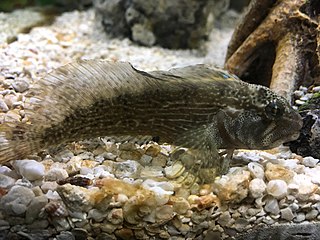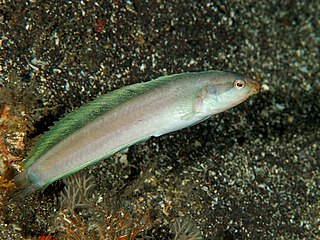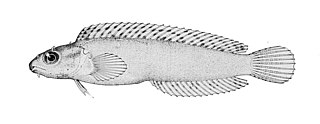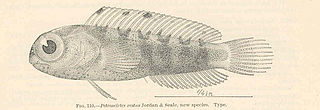
Combtooth blennies are blenniiformids; percomorph marine fish of the family Blenniidae, part of the order Blenniiformes. They are the largest family of blennies with around 401 known species in 58 generas. Combtooth blennies are found in tropical and subtropical waters in the Atlantic, Pacific and Indian Oceans; some species are also found in brackish and even freshwater environments.

The mimic blenny or piano fangblenny, Plagiotremus tapeinosoma, is a blenny of the genus Plagiotremus, with a widespread Indo-Pacific distribution including New Zealand from depths of 8 to 30 metres. This species reaches a length of 14 centimetres (5.5 in) TL.
Breviceps fuscus, also known as black rain frog, plain rain frog, brown short-headed frog, and Tsitsikama rainfrog, and is a species of frogs in the family Brevicipitidae. It is endemic to South Africa. The specific name fuscus refers to the dark coloration of this species.

Meiacanthus grammistes the striped blenny, also called the striped fang blenny, grammistes blenny, line-spot harptail blenny or striped poison-fang blenny, is a species of combtooth blenny from the western Pacific Ocean. The fish stays in the open ocean, but travels into shallow saltwater and brackish estuaries. This venomous species occasionally makes its way into the aquarium trade.

Chasmodes bosquianus, the striped blenny, is a species of combtooth blenny found in the western Atlantic ocean, from New York to Florida. The specific name uses the suffix-ianus to denote "belonging to" and refers to the French naturalist Louis Augustin Guillaume Bosc (1759-1828), whose notes Bernard Germain de Lacépède used to base his description of this blenny.
Meiacanthus ditrema, the one-striped poison-fang blenny, is a species of combtooth blenny found in coral reefs in the western Pacific ocean. This species grows to a length of 6 centimetres (2.4 in) TL.

Petroscirtes is a genus of combtooth blennies found in the western Pacific, and Indian oceans. Some species of this genus have venom that interacts with opioid receptors. Adults usually inhabit coastal reefs and estuaries to depths of about 10 meters, but they can also be found up to 15 meters in depth in sandy and weedy areas among clumps of Sargassum or other seaweeds in coastal and lagoon reefs. They can be found in nests inside small-necked bottles and abandoned worm tubes or shells.

Petroscirtes ancylodon, the Arabian fangblenny, is a species of combtooth blenny found in the western Indian ocean. The species now also occurs in Iskenderun Bay in the Mediterranean, having invaded as a Lessepsian migrant through the Suez Canal. Males of this species reaches a length of 11.5 centimetres (4.5 in) TL while females reach a maximum length of 7.9 centimetres (3.1 in) SL.

Petroscirtes fallax, the deceiver fangbelly or yellow saberetooth blenny, is a species of combtooth blenny found in coral reefs in the western Pacific ocean. This species reaches a length of 9.5 centimetres (3.7 in) TL. This is a small species of blenny with a body which is yellow to whitish in colour and is marked with three longitudinal black stripes. The more ventral stripe extending onto the base of the pectoral fin although not to the base of the anal fin. This species is thought to be a possible Batesian mimic of the Lined Fangblenny, Meiacanthus lineatus, which has a pair of venomous canine-like teeth in its lower jaw.

Petroscirtes lupus, the wolf fangbelly, is a species of combtooth blenny found in coral reefs in the western Pacific ocean. This species reaches a length of 13 centimetres (5.1 in) TL. A variably greyish, brown or greenish blenny with six large dark blotches, white dots and dashes on upper sides, and dark dots below. It has two large canines in the lower jaw which are used for defence, although this species is not venomous, and they have been known to bite if handled. They live among sea grass beds, seaweed or the empty shells of molluscs. The female lays her eggs on the interior of a mollusc shell and the male guards them.
Petroscirtes marginatus is a species of combtooth blenny found in the western Pacific ocean. This species reaches a length of 4.9 centimetres (1.9 in) SL.

Petroscirtes mitratus, the floral blenny, floral fangblenny, helmeted blenny, or the crested sabretooth blenny, is a species of combtooth blenny found in coral reefs in the Pacific and Indian ocean. This species reaches a length of 8.5 centimetres (3.3 in) TL. It is the type species of the genus Petroscirtes.
Petroscirtes pylei, the twilight fangblenny, is a species of combtooth blenny found in the western central Pacific ocean, around Fiji. This species reaches a length of 4.1 centimetres (1.6 in) SL. The specific name honours the American ichthyologist Richard L. Pyle of the Bishop Museum in Honolulu.

Petroscirtes springeri is a species of combtooth blenny found in coral reefs in the northwest Pacific ocean. This species reaches a length of 7.7 centimetres (3.0 in) SL. The specific name honours the American ichthyologist Victor G. Springer of the United States National Museum, it was Springer who first introduced the author to the blenniids and who suggested the study in which Smith-Vaniz described this species.
Petroscirtes thepassii, the Thepas' sabretooth blenny or the Thepas' fangblenny, is a species of combtooth blenny found in the western central Pacific ocean. This species reaches a length of 5.9 centimetres (2.3 in) SL. The specific name of this blenny honours the collector of the type, the military surgeon A.H. Thepass.

Petroscirtes variabilis, the variable sabretooth blenny, variable fangblenny, or the variable blenny, is a species of combtooth blenny found in the western Pacific and Indian ocean. This species reaches a length of 15 centimetres (5.9 in) TL.

Petroscirtes xestus, the xestus sabretooth blenny, xestus fangblenny, or the bearded sabretooth blenny, is a species of combtooth blenny found in coral reefs in the Pacific and Indian Ocean. This species reaches a length of 7 centimetres (2.8 in) TL.

Plagiotremus rhinorhynchos, commonly called the bluestriped fangblenny, is a species of combtooth blenny found in coral reefs in the Pacific and Indian ocean. This species reaches a length of 12 centimetres (4.7 in) SL. It is also known as the bluestriped blenny, bluestriped sabretooth blenny, blunt-nose blenny, cleaner mimic, tube-worm blenny or the two-stripe blenny. They hide in deserted worm tubes or other small holes.

Plagiotremus laudandus, the bicolour fangblenny, false harptail-blenny, poison-fang blenny mimic, yellow-tailed blenny or the yellowtail fangblenny mimic, is a species of combtooth blenny found in coral reefs in the western Pacific ocean. This species reaches a length of 8 centimetres (3.1 in) TL. This species is a Batesian mimic of Meiacanthus atrodorsalis.













